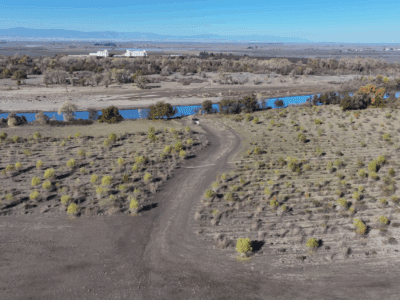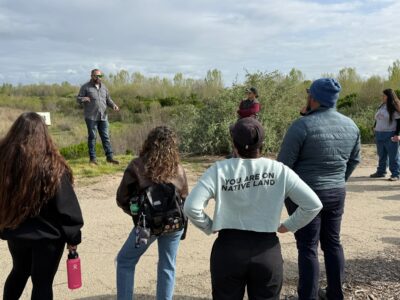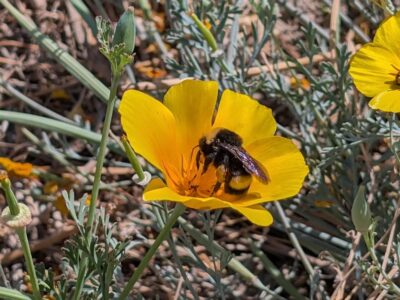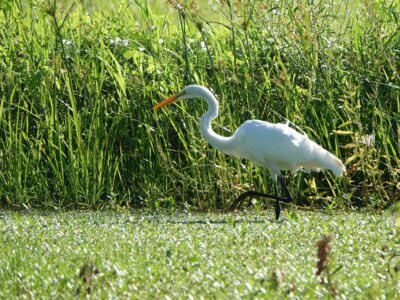River Partners’ restoration projects run up and down California and our Science and Operations staff see all sorts of wildlife. And with our new series, “Eyes in the Wild,” we’re giving our readers a glimpse into the wildlife making their home where we work—this is the latest installment of that series.
As River Partners staff continue to capture photos of wildlife sightings around the state, we want to show you what we’re seeing. From smartphones to camera traps, solitary wildlife or communal, at key sites we’ve restored statewide, the wildlife continues to tell us that revitalizing river landscapes is working.
Please check out our first two posts in the “Eyes in the Wild” series from June and July.
Native Seed Gathering (Kern County)

On an early May morning to beat the heat, Heritage Growers Wildland Seed Collector Haleigh Holgate and her team were on a seed-scouting expedition in Buttonwillow, just west of Bakersfield, in Kern County. Returning to her vehicle to fetch some data collection equipment, she was momentarily distracted and thought, “I should look down before I take this next step.” Good thing she listened to her instinct—her foot was in the air and about to land near this Western rattlesnake.
“I sidestepped and took a moment to realize that I didn’t hear a single rattle,” she said. “It seemed like it had just come from its hole and was tasting the air with its tongue while it woke up.”
The Western rattlesnake is an iconic and easily recognizable species: from the broad, triangular head and scale-covered body to the distinctive rattle at the end of its tail. While this species can strike fear in humans (and rightly so!), it plays a vital role in the ecosystem, regulating rodent populations and limiting the spread of rodent-borne diseases.
The Western rattlesnake is found throughout much of northern and central California, preferring grasslands, woodlands, chaparral, and rocky areas. While populations remain stable, this rattler can face a few localized pressures, including habitat loss from agriculture and development and being run over by vehicles while crossing roads, not to mention frequently being killed out of fear or for sport.
Imperial-Wildlife Area, Finney-Ramer Unit (Imperial County)
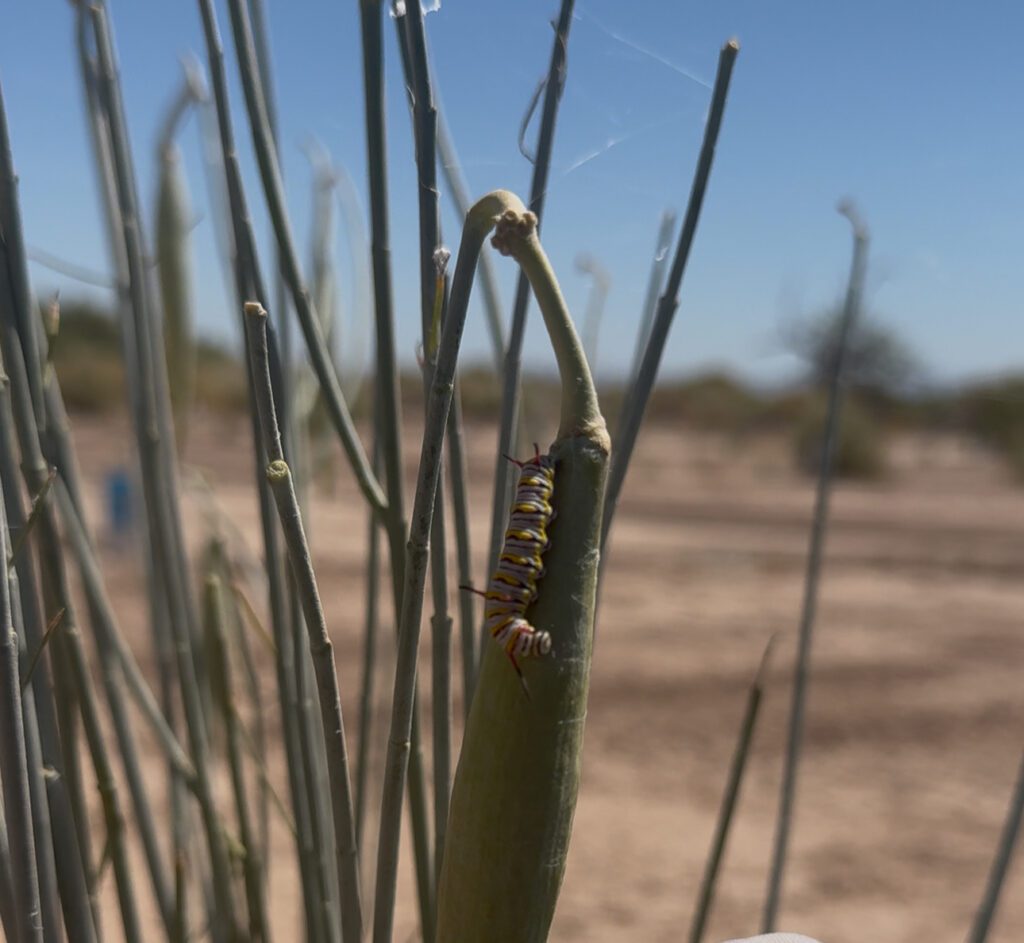
Associate Restoration Scientist Samantha Licona was at the Finney-Ramer restoration site that we’re leading with the California Department of Fish and Wildlife and California Conservation Corps, south of the Salton Sea, walking past some rush milkweed, a new species for River Partners which we added to our plant palette in spring 2024 specifically to increase diversity of resources for pollinators. To Licona’s delight, she saw and photographed this queen caterpillar enjoying its time on the thriving rush milkweed.
The queen caterpillar is the larval stage of the queen butterfly, a close relative of the iconic Western monarch butterfly, whose numbers have crashed to all-time lows over the last decade. While the two species are similar in appearance—both feature black, white, and yellow bands—monarchs have two pairs of fleshy filaments (tentacle-like antennae) and queen caterpillars have three pairs of filaments, one pair near its head, another pair near its middle, and yet another one near its rear.
Also similar to monarch butterflies, queen butterflies lay their eggs on milkweed leaves. Once the eggs hatch, the queen caterpillars feed on those milkweed plants. An important pollinator species, the queen caterpillar does not have a special conservation status. It’s adaptable and uses a variety of milkweed species and habitats and, unlike the monarch, is not a migratory species, so it’s less vulnerable to the loss of large swaths of migratory corridors. River Partners’ milkweed restoration and pollinator conservation efforts throughout California aimed at helping monarchs also benefit queens.
In fact, after the United States Fish and Wildlife Service proposed to list Monarch butterflies under the Endangered Species Act due to habitat loss, pesticides, and climate change, River Partners set an ambitious goal to plant 15 million milkweed plants across California by 2030 to support Western monarchs and other pollinators, including the queen butterfly.
Island Dairy (Stanislaus County)
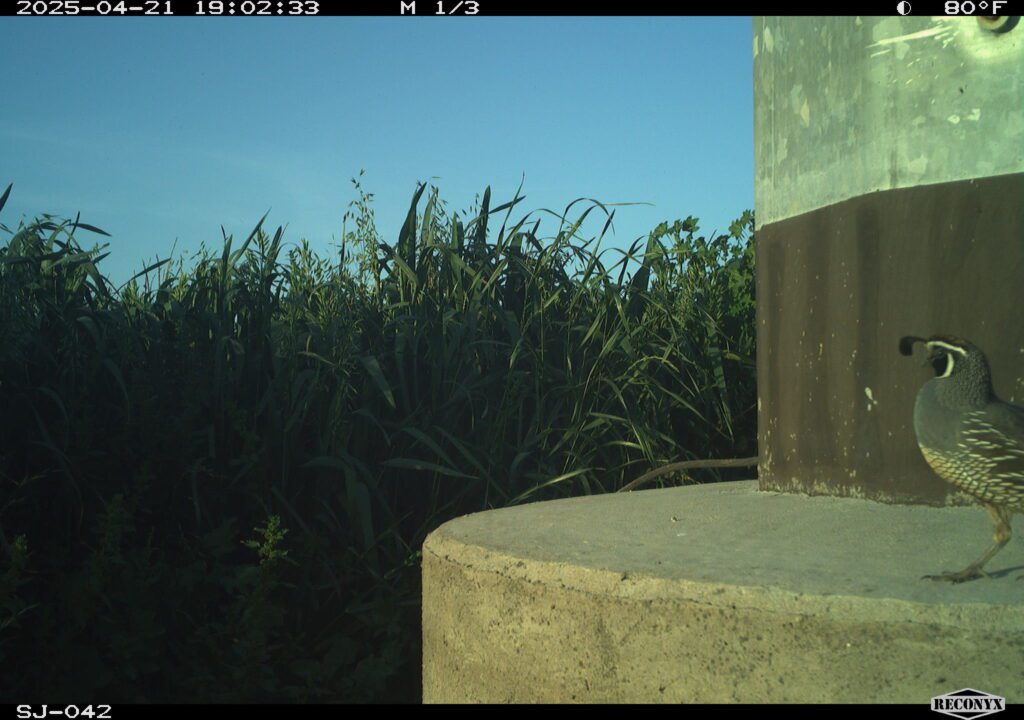
Seen along the right side of this photo is the California quail, the state’s official bird, proudly strutting its stuff at River Partners’ 480-acre Island Dairy restoration site in Stanislaus County along the San Joaquin River. This ground-dwelling bird is highly social, often seen in groups called “coveys,” and is well known for its distinctive forward-curving black plume (“topknot”) on its forehead. Males feature a bold black face with white outlining, a gray-blue chest, and a chestnut patch on their stomachs, while females are brown and gray for camouflage.
This photo’s date, April 21, provides clues as to what could be happening in the life of this male. Breeding season for quail typically runs from spring to early summer—females select nest sites, often in hollows under shrubs and brambles, and begin to lay eggs. The peak egg-laying period is generally in late April and early May, during which time male California quail become more visible and vocal. A common behavior is the “cow” call, a single, loud note often sung from a prominent perch like a tall shrub or fence post—you may even see this in your backyard—and serves to attract a mate and announce to rival males that that’s his territory.
Males also participate in numerous visual courtship displays, including “tidbitting,” where it will pick up a food item and offer it to the female. This provides her with a little extra nutrition for egg-laying, while strengthening their bond. California quail populations around the state are stable and adaptable, but localized habitat loss and predation by domestic animals (like cats) can affect numbers.
Tule Elk State Natural Reserve (Kern County)
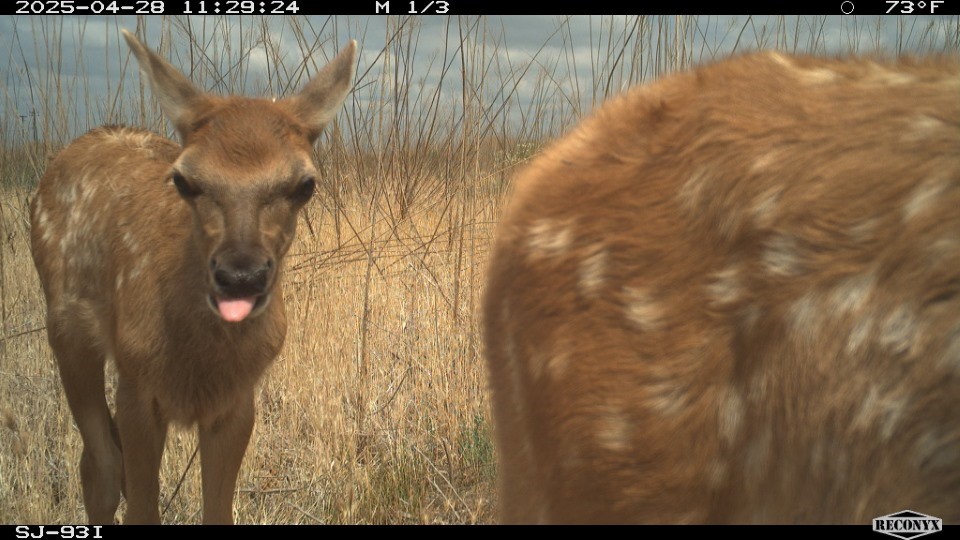
As Associate Restoration Scientist Zoe Schimnowski scanned through camera trap photos from Tule Elk State Natural Reserve in Kern County, where River Partners is working to conserve and enhance critical habitats to benefit a range of wildlife, she couldn’t resist sharing this photo of two of the calves born there this year. Located about 25 miles west of Bakersfield, the Reserve is 965 acres of conserved lands dedicated to imperiled tule elk. Protecting a small herd of tule elk, once on the verge of extinction, the Reserve has been critical for the successful recovery of elk populations across the state. Like many deer and elk species, these calves were born with white spots that help with camouflage.
Tule elk are the smallest of all North American elk subspecies and found only in California, making it a uniquely important part of the state’s natural heritage. Once reduced to around 30 individuals in the 1870s, tule elk have rebounded thanks to legal protections, relocation to new habitats, and restoration efforts from the California Department of Fish and Wildlife, NGOs like River Partners, and Indigenous groups. Today, with more than 5,000 tule elk now roaming across California, it’s classified as a species of Least Concern.
Tule elk are culturally important to many Indigenous tribes, holding profound spiritual significance, featured in traditions, and serving as a symbol of resilience and the deep connection between people and the natural world. This bond has endured through periods of plenty near-extinction, and, now, a new era of Tribal involvement in their conservation.
Willow Bend Preserve (Colusa County)
Field Foreman Eligio Hernandez added this impressive video which he captured at our 175-acre Willow Bend Preserve in Colusa County. In the ensuing conversation about what this might be (a log, a fish?), senior Restoration Science Ecologist Mike Davis said it was likely a sturgeon. Davis said identification was difficult based on the small portion of the fish that was visible, but he leaned toward green sturgeon.
Sturgeon are known to hold a fixed position in flowing rivers when feeding, allowing the river current to bring drifting food to them. Said Davis, “With its dorsal fin poking out and the way it’s holding itself on the bottom, it’s common sturgeon behavior.” And that while this video doesn’t definitively reveal the size, he said this fish “does look like a large one.” Green sturgeon can reach lengths of up to about nine feet and weigh about 350 pounds.
Seeing a sturgeon near the surface of the water like this isn’t a common sight in the Central Valley. They’re usually only seen when caught while fishing or when stranded in man-made canals and other infrastructure that prove difficult for them to navigate.
With fossil evidence suggesting that sturgeon existed as far back as 200 million years ago (they were around before the dinosaurs), they are also among the most imperiled groups of animals on the planet. Their populations globally have been decimated by overfishing (think caviar), habitat degradation, fragmentation, and pollution. In California, the white sturgeon is a candidate species for listing as threatened; the green sturgeon is listed as near threatened.


